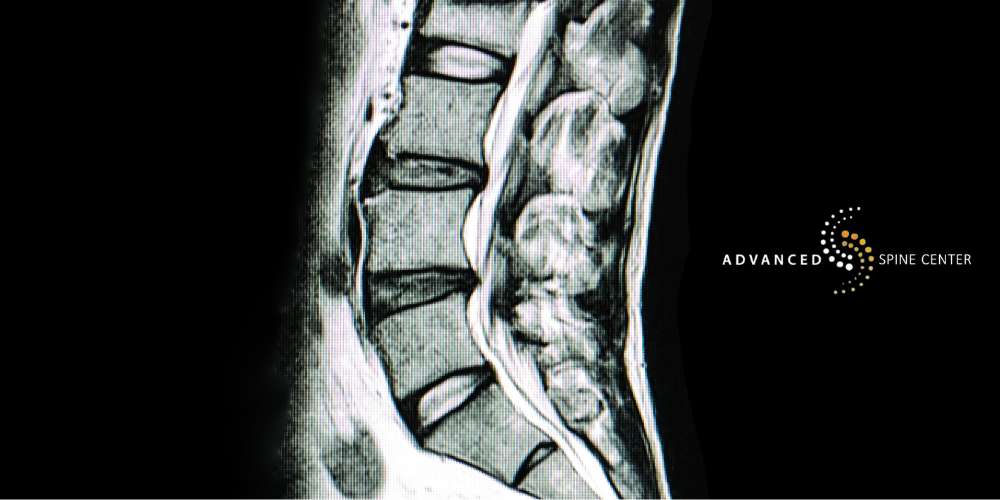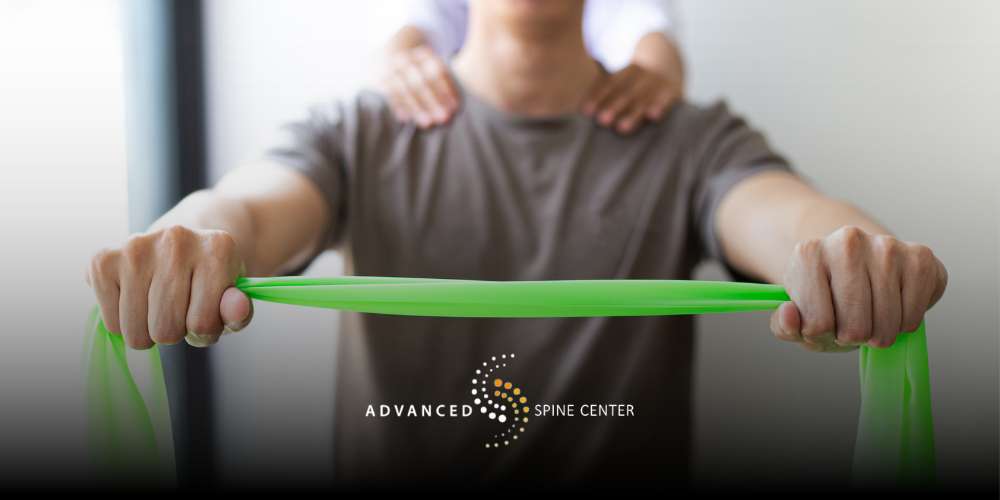Kyphosis is a condition characterized by an excessive outward curvature of the spine. If you or a loved one is living with this condition, you may wonder, “Can kyphosis be reversed?” While the answer depends on several factors, including the type and severity of kyphosis, treatment options are available to help manage symptoms and, in some cases, improve spinal alignment.
At the Advanced Spine Center in Plano, TX, Dr. Stephen Courtney and our team of spine specialists provide personalized care and effective treatments to help alleviate discomfort and support your spinal health—call (972) 499-5457 to schedule a consultation with a spine specialist today.
What Is Kyphosis?
Kyphosis refers to an abnormal curvature of the spine that results in a forward rounding of the upper back, giving a hunched or slouched appearance. While the thoracic spine naturally has a slight curve to support proper posture, kyphosis occurs when this curvature becomes excessive.
Kyphosis can develop in the thoracic region, cervical spine, or even the lumbar spine, and its symptoms may include stiffness, pain, or noticeable changes in spinal alignment. If left untreated, kyphosis can affect spinal health and overall mobility.
What Causes Kyphosis?

Kyphosis can have various causes, ranging from chronic poor posture to underlying structural abnormalities in the spine. In some cases, postural kyphosis develops due to habits like slouching, which place mechanical stress on the spine over time.
Unlike postural kyphosis, other types, such as Scheuermann’s kyphosis, result from irregular growth of the vertebrae during adolescence, leading to a more pronounced forward curvature. Additional causes include compression fractures from osteoporosis, traumatic injuries, and neuromuscular disorders that weaken spinal and core strength.
Is Kyphosis Genetic?
Kyphosis can have a genetic component, particularly in cases like congenital kyphosis and Scheuermann’s kyphosis, where structural abnormalities in the spine may run in families. Congenital kyphosis occurs when the spine develops abnormally before birth, and in some cases, there may be a hereditary link. Similarly, Scheuermann’s kyphosis, which commonly affects adolescents, can also have a genetic predisposition. However, not all types of kyphosis are influenced by genetics.
Is Kyphosis Reversible?

Whether kyphosis is reversible depends on the type and severity of the condition. For instance, postural kyphosis is often reversible through lifestyle changes, physical therapy, and exercises that promote a healthy spine.
However, more severe forms, such as congenital kyphosis or Scheuermann’s kyphosis, may require advanced interventions, including corrective bracing or spinal surgery, to address the structural abnormality.
Each type of kyphosis presents unique challenges and treatment possibilities, and understanding the specific cause is key to determining the best approach. In the sections below, we’ll explore the different types of kyphosis, including thoracic kyphosis, cervical kyphosis, and hyperkyphosis.
Can Kyphosis Be Reversed in Adults?
Reversing kyphosis in adults depends on what caused it and how severe the condition has progressed. Postural kyphosis from poor posture can often improve with exercises, physical therapy, and posture correction to strengthen core muscles and enhance spinal alignment. Structural cases, such as Scheuermann’s kyphosis or those caused by compression fractures, may require spinal surgery to correct the extreme curvature of the spine.
Can Congenital Kyphosis Be Reversed?
Congenital kyphosis, caused by abnormal spinal development before birth, is challenging to reverse without intervention. While non-surgical methods like physical therapy can help manage symptoms, significant correction often requires spinal fusion surgery to stabilize the spine and address the kyphotic curve.
Can Postural Kyphosis Be Reversed?
Postural kyphosis can often be reversed, especially if addressed early. This type of kyphosis is typically managed through lifestyle adjustments, such as improving posture and engaging in exercises that strengthen the core muscles and improve spinal alignment. Regular practice of spinal extension exercises and physical therapy can help restore a normal spine and prevent the condition from worsening.
Can Cervical Kyphosis Be Reversed?
Reversing cervical kyphosis, or an excessive forward curvature of the cervical spine, depends on its cause. Mild cases resulting from poor neck posture may be improved through exercises and physical therapy. In cases caused by traumatic injuries or structural deformities, treatment might involve bracing or surgical treatment to correct the alignment of the cervical or lumbar spine.
Can Thoracic Spine Kyphosis Be Reversed?
Reversing thoracic kyphosis depends on its underlying cause. For cases of postural thoracic kyphosis, improvements can often be achieved through correct posture, targeted exercises, and physical therapy.
Structural kyphosis, such as Scheuermann’s kyphosis, may require advanced treatments, including spinal fusion surgery, to correct the abnormal spinal curve. While it may not always be possible to fully reverse thoracic kyphosis, treatment can significantly reduce symptoms, improve alignment of the thoracic spine, and enhance overall quality of life.
Can Thoracolumbar Kyphosis Be Reversed?
Thoracolumbar kyphosis, which impacts the area where the thoracic and lumbar spine meet, can sometimes be improved depending on its cause. For cases caused by poor posture, targeted exercises, and physical therapy can help correct the spinal curvature and enhance spinal alignment.
However, structural issues, such as those resulting from traumatic injuries or compression fractures, may require spinal fusion surgery to stabilize the spine and reduce the kyphotic curve.
Can Hyperkyphosis Be Fixed?
Hyperkyphosis, an exaggerated rounding of the upper back, can often be managed or improved with the right treatment approach. In mild to moderate cases, physical therapy, posture correction, and exercises can be effective in reducing the kyphotic curve. Severe cases or those caused by a structural abnormality may require spinal surgery to correct kyphosis and prevent further complications.
Kyphosis Treatment Options in Plano

Treating kyphosis requires a personalized approach, as every case is unique. At the Advanced Spine Center in Plano, we offer comprehensive treatment options designed to address each patient’s needs.
From non-invasive therapies and corrective exercises to advanced solutions such as spinal fusion surgery, our team is dedicated to improving spinal alignment and relieving symptoms. Whether you’re dealing with postural kyphosis, structural kyphosis, or a combination of factors, we focus on restoring your comfort and mobility while promoting long-term spinal health.
Kyphosis Treatment in Adults
Treating kyphosis in adults often involves a combination of therapies tailored to the individual’s condition. For postural kyphosis, non-invasive methods such as physical therapy, posture correction, and strengthening exercises can help improve spinal alignment and reduce discomfort.
For structural issues like Scheuermann’s kyphosis or kyphosis caused by compression fractures, treatments may include bracing or, in severe cases, spinal surgery. Early diagnosis and a proactive treatment plan can prevent further progression and relieve chronic symptoms in adults.
Kyphosis Surgery
In Plano, kyphosis surgery may be necessary for severe cases or when non-surgical methods are ineffective. Procedures like spinal fusion surgery can correct the kyphotic curve by stabilizing and realigning the affected vertebrae. Surgery is often recommended for cases involving significant pain, spinal cord compression, or a progressive abnormal spinal curve.
Kyphosis Exercises
Exercising is key in treating kyphosis, especially in cases caused by poor posture. Stretching and strengthening the core muscles and back can help improve spinal alignment and reduce the kyphotic curve. Specific movements like spinal extension exercises and posture correction drills focus on enhancing flexibility and reducing mechanical stress on the spine.
Treatment for Kyphosis in Elderly Patients
Treating kyphosis in elderly patients often requires a cautious approach. For conditions like hyperkyphosis or kyphosis caused by compression fractures, treatment may include physical therapy, corrective bracing, and medications to manage pain or underlying conditions like osteoporosis.
Gentle, low-impact exercises can help improve mobility, strengthen the spine, and alleviate symptoms. In severe cases, spinal surgery may be considered to stabilize the spine and prevent further damage.
How to Prevent Kyphosis and Damage to the Spinal Cord

Preventing kyphosis and protecting the spinal cord begins with adopting healthy habits that promote a healthy spine and improve spinal alignment. While some causes of kyphosis may be unavoidable, such as genetic factors or congenital conditions, lifestyle changes can significantly reduce the risk of developing or worsening the condition.
Simple adjustments, such as maintaining good posture, staying active, and avoiding harmful habits, can help support spinal health and prevent unnecessary strain on the spine.
Exercise Frequently and Improve Your Posture
Regular exercise is essential for maintaining a normal spine and reducing the risk of kyphosis. Strengthening the core muscles and practicing spinal extension exercises can improve spinal alignment and support proper posture throughout daily activities.
Incorporating stretching routines and targeted workouts helps prevent stiffness and encourages flexibility, which is key to avoiding excessive spinal curvature. Combining physical activity with mindful posture practices can significantly enhance your overall spinal health.
Maintain a Healthy Weight
Maintaining a healthy weight is crucial for reducing the strain on your spine and preventing the development of abnormal curvature. Excess body weight, particularly in the abdomen, increases the risk of mechanical stress on the vertebrae, potentially contributing to conditions like thoracic kyphosis or hyperkyphosis.
A balanced diet and regular exercise help you stay within a healthy weight range and support spinal and core strength, reducing the risk of kyphotic curves and other spinal issues.
Stop Smoking
Smoking can weaken the spine by reducing blood flow and oxygen, which are essential for maintaining strong bones and discs. It also contributes to the development of conditions like osteoporosis, which can increase the risk of compression fractures and kyphosis.
Quitting smoking helps preserve spinal health and prevents damage to the spinal cord, reducing the likelihood of developing or worsening spinal deformities like excessive kyphosis.
Participate in Low-Impact Exercises
Low-impact exercises, such as walking, swimming, and yoga, are excellent for promoting spinal health without placing unnecessary strain on the spinal cord or joints. These activities improve flexibility, enhance spinal alignment, and strengthen the core, which is crucial for preventing and managing kyphotic curves. Incorporating low-impact activities into your routine can also reduce the risk of injuries and help maintain a healthy spine over time.
Contact a Kyphosis Doctor in Plano at the Advanced Spine Center Today

If you or a loved one is struggling with kyphosis or experiencing symptoms like pain, stiffness, or noticeable changes in posture, seeking help from a qualified spine specialist is the first step toward relief.
At Advanced Spine Center, Dr. Stephen Courtney and his team are dedicated to treating kyphosis with personalized care and advanced solutions designed to restore your comfort and mobility.
Whether you’re dealing with postural kyphosis, a structural abnormality, or chronic back pain, we’re here to help you achieve a healthier spine and better quality of life. Contact Advanced Spine Center at (972) 499-5457 to schedule a consultation and take the first step toward improved spinal health.










